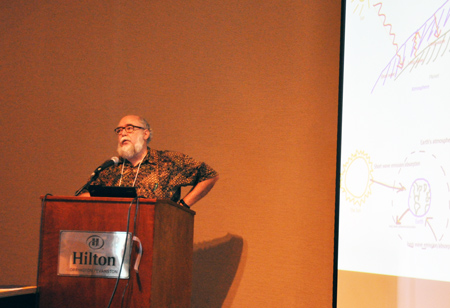Conference Highlights Importance of Spatial Learning in Undergraduate STEM Education
Nearly 80 faculty, staff, and graduate students from more than three-dozen universities attended the two-day meeting
Nearly 80 faculty, staff, and graduate students from more than three-dozen universities across the country convened at Northwestern University on September 18 and 19 to discuss the role of spatial learning in undergraduate science, technology, engineering, and mathematics (STEM) education.
The conference, Integrating Cognitive Science with Innovative Teaching in STEM Disciplines: Spatial Learning in STEM, included presentations and breakout sessions on the importance of spatial skills for students studying engineering, natural sciences, and biological sciences, and how those skills can be improved.
“Universities today are increasingly challenged to make education accessible and affordable,” said Ronald Braeutigam, associate provost for undergraduate education at Northwestern during the conference’s opening remarks. “If we can improve the STEM learning experience through conferences like this and the products that emerge from them, it’s going to pay dividends for students.”
 Among the event’s presenters was Northwestern Engineering’s Ken Forbus, who spoke on the importance of sketching as a method for STEM students to develop spatial understanding. Forbus is developing CogSketch, an AI software platform that enhances sketch-based learning through immediate, interactive feedback.
Among the event’s presenters was Northwestern Engineering’s Ken Forbus, who spoke on the importance of sketching as a method for STEM students to develop spatial understanding. Forbus is developing CogSketch, an AI software platform that enhances sketch-based learning through immediate, interactive feedback.
“Sketching is an aid to thinking. It involves not only spatial understanding, but also conceptual knowledge,” said Forbus, Walter P. Murphy Professor of Electrical Engineering and Computer Science. “In designing CogSketch, we sought to build software that’s fluid and natural to interact with and is human-like in its visual understanding so it can provide effective feedback.”
One of the tools available through the CogSketch platform is Sketch Worksheets, a program Forbus said addresses the need for on-the-spot feedback for students who submit sketches for evaluation. After a student completes a sketch worksheet in CogSketch, the AI component of the software kicks in, comparing the instructor’s sketch with the student’s. In a matter of moments, the program can share any gaps between the two creations that may exist, allowing students to recognize and correct their mistakes immediately.
“A recent survey showed eighty percent of college geoscience instructors say sketching is important in understanding geological concepts,” said Forbus. “But less than half of them assign sketches more than three times per semester because they are so time-consuming to grade.”
According to Forbus, more than 500 students have used Sketch Worksheets in classroom and laboratory experiments ranging from geoscience to biology to engineering. He hopes the software’s adoption spreads so it is one day treated like a calculator: always available and capable of a variety of uses.
“If you can make grading more efficient for the instructor and still provide quality feedback for the student, everyone will be helped,” said Forbus.
The conference was the third in a series of collaborative meetings—previously held at Washington University in St. Louis in 2012 and 2014—designed to bridge the gap between cognitive science experts and STEM educators. This year’s meeting was co-chaired by Northwestern Engineering’s Robert A. Linsenmeier, professor of biomedical engineering, neurobiology, and ophthalmology, and David H. Uttal, professor of psychology and education at Northwestern.
“The research findings presented by our speakers show that spatial skills are just as important as verbal and math skills to educational and career success in STEM, and that modest interventions early in college can dramatically improve spatial learning and retention,” said Linsenmeier. “Conference attendees valued the opportunity to discuss these topics across the usual disciplinary boundaries.”
The conference was sponsored by the McCormick School of Engineering and Applied Science through the Northwestern Center for Engineering Education Research (NCEER), the Weinberg College of Arts and Sciences, the Office of the Associate Provost for Undergraduate Education at Northwestern, and the National Science Foundation’s Spatial Intelligence and Learning Center (SILC).